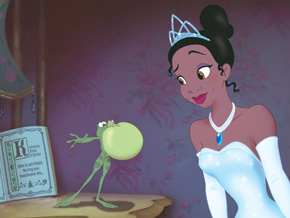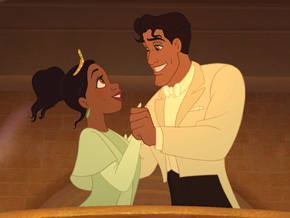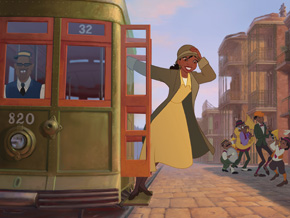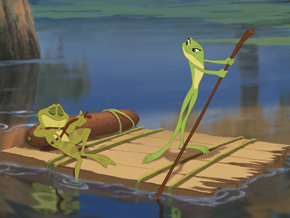Someday My Princess Will Come

Photo: Disney Enterprises, Inc.
Efforts to affect change are never without controversy, even when they come from the purest, most magical land. In December, Walt Disney animation is returning to its hand-drawn roots to introduce someone little girls have never met before: an African-American princess. The Princess and the Frog revolves around Princess Tianna, a 1920s New Orleans waitress and aspiring restaurant owner who is persuaded to kiss a frog in order to turn him back into a human (Oprah voices the princess's mother). But in this rendition of the classic fairy tale, the amphibian doesn't become a prince. Instead, the princess becomes a frog.
The depiction of Princess Tianna is a landmark decision for The Mouse. There have been white, Asian, Native American and Arab heroines, so it seems the time for an African-American princess is long overdue. "[Princess Tianna] delivers affirmation to little girls who look like this girl," says Anika Noni Rose, who voices the barrier-breaking princess. "She delivers a sense of partnership between other little girls who have friends and family members who look like Tianna. I think in the world of fantasy, and I'm not just talking about Disney, the dark character has always been associated with evil—the black hat is the bad cowboy—and this is the flip. It's wonderful to see something different, and it will be effective on many fronts to many children, and consequently to many adults years from now."
The depiction of Princess Tianna is a landmark decision for The Mouse. There have been white, Asian, Native American and Arab heroines, so it seems the time for an African-American princess is long overdue. "[Princess Tianna] delivers affirmation to little girls who look like this girl," says Anika Noni Rose, who voices the barrier-breaking princess. "She delivers a sense of partnership between other little girls who have friends and family members who look like Tianna. I think in the world of fantasy, and I'm not just talking about Disney, the dark character has always been associated with evil—the black hat is the bad cowboy—and this is the flip. It's wonderful to see something different, and it will be effective on many fronts to many children, and consequently to many adults years from now."

Photo: Disney Enterprises, Inc.
In a country that just elected its first African-American president, one would think Disney's decision would be embraced, if perhaps chided for taking too long. But no good deed goes unpunished, and six months before the film's release—before the official trailer had even been blessed—the company fell under fire for a number of its artistic decisions. Based solely on photographs and written descriptions, Disney took hits for not portraying the movie's Prince Charming as African-American (Prince Naveen from the fictional Maldonia is voiced by a Brazilian actor). It was criticized for choosing New Orleans as the story's backdrop. After critics caught wind of an early trailer, Princess Tianna's sidekick Ray the Firefly was attacked for sounding too stereotypically uneducated. It seemed Disney couldn't win.
"I understand that people are frightened because history hasn't been kind to black Americans in the land of animation," Rose says, likely referring to "Jim Crow" and his flock in Dumbo, and the Jungle Book monkeys who are dying to become "real people" and talk in jive while the other characters have British accents. "But this is something that Disney has been wanting to do for a long time. They certainly don't want to offend anyone, least of all me. I'm in the studio! So there's been a lot of care put into this project. I know there's deep-seeded pain within the culture about the way we've been portrayed onscreen throughout the years, but I think this is made only in love and with the desire to kick off the shroud that has been sitting over Disney for so long."
Plus, Rose points out, this movie is for kids. Though it shouldn't ridicule, it should make us laugh. "The firefly is funny," she says. "It's not in ugly jest. He's Cajun and he makes fun of himself, and there are lots of different portrayals in the movie. I am not one to sit up here and boost buffoonery. You really have to see it in context. It's not something that's meant to denigrate in the least."
"I understand that people are frightened because history hasn't been kind to black Americans in the land of animation," Rose says, likely referring to "Jim Crow" and his flock in Dumbo, and the Jungle Book monkeys who are dying to become "real people" and talk in jive while the other characters have British accents. "But this is something that Disney has been wanting to do for a long time. They certainly don't want to offend anyone, least of all me. I'm in the studio! So there's been a lot of care put into this project. I know there's deep-seeded pain within the culture about the way we've been portrayed onscreen throughout the years, but I think this is made only in love and with the desire to kick off the shroud that has been sitting over Disney for so long."
Plus, Rose points out, this movie is for kids. Though it shouldn't ridicule, it should make us laugh. "The firefly is funny," she says. "It's not in ugly jest. He's Cajun and he makes fun of himself, and there are lots of different portrayals in the movie. I am not one to sit up here and boost buffoonery. You really have to see it in context. It's not something that's meant to denigrate in the least."

Photo: Disney Enterprises, Inc.
As for the movie's location, Rose says the fact that New Orleans was the site of so much tragedy for the African-American community is exactly why it's the perfect setting for The Princess and the Frog. "Where else do children need to see themselves as progressive and strong and having the ability to make their dreams come true?" she says. "Even if it's something that takes place in the past, the message lives right now. New Orleans needs that. New Orleans needs to know in no uncertain terms that the heritage that lives there—in their music, in their food—these things are not only viable but a part of the makings of the fabric of this country and worthy of celebrating."
The look of Princess Tianna isn't the only change worth noting in The Princess and the Frog. After a long run of CGI, Disney is returning to its original art form, and Rose says New Orleans is just the subject to help them show off the medium they pioneered. "They've captured the heat of that city in their drawing," she says. "It's palpable. There's a haze in it." But why take the step backward? "There's a romanticism with hand-drawn animation that you lose when you move into CGI. When you're talking about a fairy tale, I think there's a softness around the edges that you can't get with a computer," she says. "I'm not an artist—some people might argue: 'Yes, you can! You just hit Control-F3!' But I think there's no one who does hand-drawn animation like Disney. Even their color palette is so distinct."
Rose says The Incredibles and Monsters, Inc. are two of her favorite movies, but that hand-drawn animation as an art form must be preserved before it's lost altogether. "I think it's worth keeping some of the classic things we do in life," she says. "Which doesn't mean that we shouldn't step forward, but you don't have to throw something away to use something else."
The look of Princess Tianna isn't the only change worth noting in The Princess and the Frog. After a long run of CGI, Disney is returning to its original art form, and Rose says New Orleans is just the subject to help them show off the medium they pioneered. "They've captured the heat of that city in their drawing," she says. "It's palpable. There's a haze in it." But why take the step backward? "There's a romanticism with hand-drawn animation that you lose when you move into CGI. When you're talking about a fairy tale, I think there's a softness around the edges that you can't get with a computer," she says. "I'm not an artist—some people might argue: 'Yes, you can! You just hit Control-F3!' But I think there's no one who does hand-drawn animation like Disney. Even their color palette is so distinct."
Rose says The Incredibles and Monsters, Inc. are two of her favorite movies, but that hand-drawn animation as an art form must be preserved before it's lost altogether. "I think it's worth keeping some of the classic things we do in life," she says. "Which doesn't mean that we shouldn't step forward, but you don't have to throw something away to use something else."

Photo: Disney Enterprises, Inc.
For her part, Rose says she's wanted to voice a Disney character—any Disney character—all her life. "It's miraculous that I was able to land this role not being an Oscar® winner or some major headlining person," she says. In her determination to land the part, Rose says she brought in about 10 different songs for the audition. "In my mind, this was mine. This part was for me, so I wasn't giving any kind of leeway for them to say, 'If only we could have heard...' No, whatever you could have heard, I was bringing it.'"
Known mostly for her theater work and her role in Dreamgirls, Rose says doing an animated film was an entirely different beast. "It's like accessing your inner child. You're creating every moment there is—if you are jumping on the trampoline in the movie, there's no trampoline in the studio, you're jumping up and down. If there's a dragon breathing down your neck and you have fire in your ear, nobody's lighting a match behind you," she says. "You really have to let go of what is considered acceptable and normal in society and just go further than your friend would think was okay if you were driving down the street together. You know, if you were in the mall with one of your friends and you did some of this stuff, they might call 911. They might get you a real snug jacket."
So despite early criticism, for now Rose is simply asking fans and critics alike to reserve judgment on The Princess and the Frog until the movie's December 11 release. "I love the movie," she says. "I would love for people to see the movie. It's very difficult to base thoughts on something that hasn't been seen yet."
Known mostly for her theater work and her role in Dreamgirls, Rose says doing an animated film was an entirely different beast. "It's like accessing your inner child. You're creating every moment there is—if you are jumping on the trampoline in the movie, there's no trampoline in the studio, you're jumping up and down. If there's a dragon breathing down your neck and you have fire in your ear, nobody's lighting a match behind you," she says. "You really have to let go of what is considered acceptable and normal in society and just go further than your friend would think was okay if you were driving down the street together. You know, if you were in the mall with one of your friends and you did some of this stuff, they might call 911. They might get you a real snug jacket."
So despite early criticism, for now Rose is simply asking fans and critics alike to reserve judgment on The Princess and the Frog until the movie's December 11 release. "I love the movie," she says. "I would love for people to see the movie. It's very difficult to base thoughts on something that hasn't been seen yet."
Keep Reading






